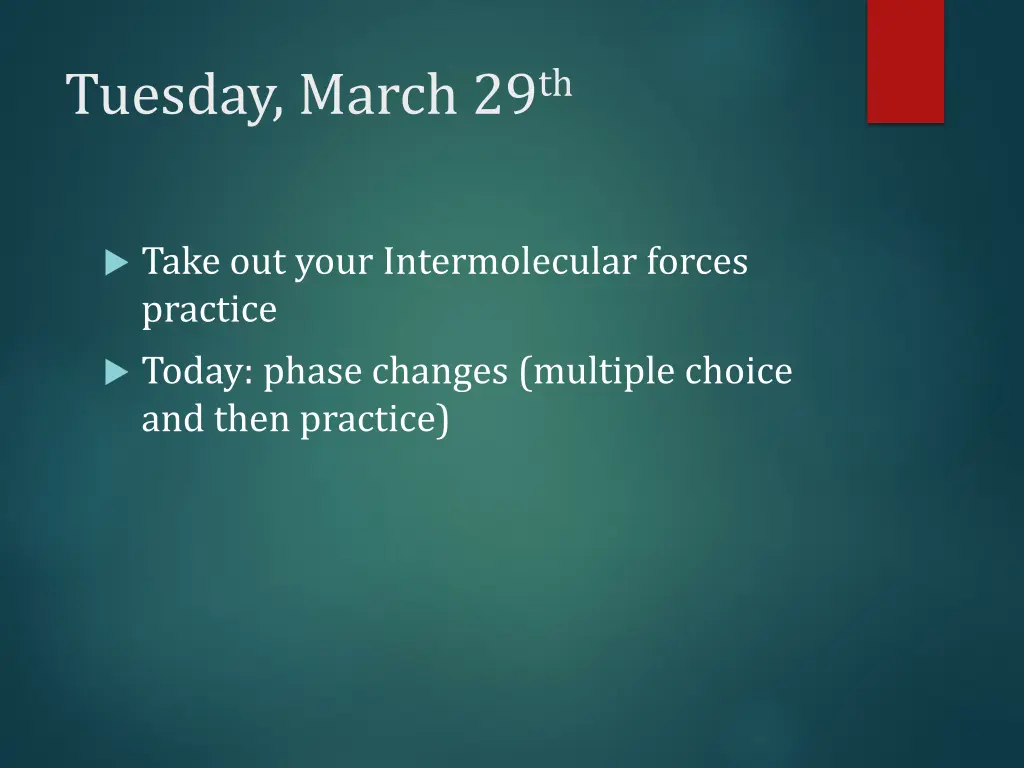
Intermolecular Forces: Phase Changes Practice - March 29th
"Practice phase changes with multiple-choice questions on energy requirements for heating, vaporization, and phase diagrams. Explore acetone and ethanol properties for a better understanding of intermolecular forces."
Download Presentation

Please find below an Image/Link to download the presentation.
The content on the website is provided AS IS for your information and personal use only. It may not be sold, licensed, or shared on other websites without obtaining consent from the author. If you encounter any issues during the download, it is possible that the publisher has removed the file from their server.
You are allowed to download the files provided on this website for personal or commercial use, subject to the condition that they are used lawfully. All files are the property of their respective owners.
The content on the website is provided AS IS for your information and personal use only. It may not be sold, licensed, or shared on other websites without obtaining consent from the author.
E N D
Presentation Transcript
Tuesday, March 29th Take out your Intermolecular forces practice Today: phase changes (multiple choice and then practice)
A 29.0 g sample of acetone is heated from a solid at 94.8 C to 50.0 C. How much energy is required for this change? a. 2.80 kJ b. 5.64 kJ c. 6.18 kJ d. 2.96 kJ e. 7.84 kJ 94.8 C 5.69 kJ/mol 2.15 J/g K 58.01 g/mol Melting point Hfus c Molar mass
A 29.0 g sample of acetone is heated from a solid at 94.8 C to 50.0 C. How much energy is required for this change? a. 2.80 kJ b. 5.64 kJ c. 6.18 kJ d. 2.96 kJ e. 7.84 kJ 94.8 C 5.69 kJ/mol 2.15 J/g K 58.01 g/mol Melting point Hfus c Molar mass
How much energy is required to vaporize 32.9 g of ethanol at its boiling point, if its Hvap is 40.7 kJ/mol? a. 28.9 kJ b. 3.83 kJ 6.30 kJ d. 17.6 kJ e. 7.60 kJ c.
How much energy is required to vaporize 32.9 g of ethanol at its boiling point, if its Hvap is 40.7 kJ/mol? a. 28.9 kJ b. 3.83 kJ 6.30 kJ d. 17.6 kJ e. 7.60 kJ c.
A sample is at the temperature and pressure indicated by point a on the phase diagram below. What phase is present after the temperature is increased to the critical temperature at constant pressure? a. gas b. liquid c. solid d. More than one phase is present.
A sample is at the temperature and pressure indicated by point a on the phase diagram below. What phase is present after the temperature is increased to the critical temperature at constant pressure? a. gas b. liquid c. solid d. More than one phase is present.
What phases are present at point f on the given phase diagram? gas and liquid gas and solid liquid and solid gas, liquid, and solid a. b. c. d.
What phases are present at point f on the given phase diagram? gas and liquid gas and solid liquid and solid gas, liquid, and solid a. b. c. d.
Homework Phase Change Practice Read 12.1-12.4 (~15 pages) Ch 7 and 8 retake deadlines are both this Friday Ch 9-10 retake deadline is Thursday, April 14th Your spring break homework will be to read ch 13 (~40 pages) do online homework (not set up yet) Take an AP practice exam


